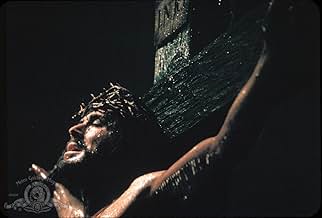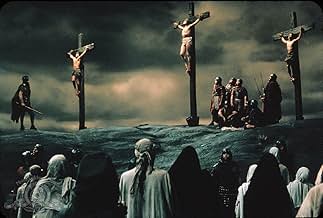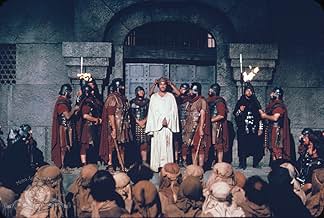La plus grande histoire jamais contée
Titre original : The Greatest Story Ever Told
- 1965
- Tous publics
- 4h 20min
NOTE IMDb
6,6/10
13 k
MA NOTE
Un film épique à grande échelle qui raconte la vie et le ministère de Jésus-Christ.Un film épique à grande échelle qui raconte la vie et le ministère de Jésus-Christ.Un film épique à grande échelle qui raconte la vie et le ministère de Jésus-Christ.
- Réalisation
- Scénario
- Casting principal
- Nommé pour 5 Oscars
- 1 victoire et 6 nominations au total
Avis à la une
I first saw this film when it was first released -- in the cinema and on a large screen with brilliant color and rich deep stereo sound. It was breathtaking! George Stevens Jr. did an absolutely magnificent job in crafting this outstandingly beautiful, sensitive, and powerful motion picture. This was not just a deeply moving re-telling of the story of Jesus (albeit with a touch of a pro-legend approach). More than that, in its visual sweep, insightful acting of the lead characters (especially of Max Von Sydow as Jesus), and resplendent musical track, this film conveyed a true sense of majesty -- a marked rarity in most film these days.
I must concur with one of the other online reviewers here, on a related point: I too believe that it was a shame, and an error on the part of Stevens, that various key characters were portrayed all-too-noticeably by some major film/entertainment stars who just seemed to be bizarrely out-of-place in their roles -- such as John Wayne as the Roman Centurion who, never before seen in the film until this moment, looks up at Jesus on the Cross and says "Truly, this man was the son of God!" (I almost expected Wayne to tag his line with the word "Pilgrim"); or such as singer Pat Boone, who jarringly appears in the role of a cloaked man who, sitting in Jesus' vacated tomb, says to a searching Roman, "Why seek Ye the living among the dead?" (Here too, I think that I was not the only one who half-expected Boone to leap to his feet and break out into singing one of his big hits such as "Bernardine" or "Love Letters In The Sand").
But those discontinuities aside, I would still say that "The Greatest Story Ever Told" is an outstanding film that merits very high marks. If you can see it, see it -- especially on a big screen, if possible, and with a good sound-system.
Steve S. (NYC)
I must concur with one of the other online reviewers here, on a related point: I too believe that it was a shame, and an error on the part of Stevens, that various key characters were portrayed all-too-noticeably by some major film/entertainment stars who just seemed to be bizarrely out-of-place in their roles -- such as John Wayne as the Roman Centurion who, never before seen in the film until this moment, looks up at Jesus on the Cross and says "Truly, this man was the son of God!" (I almost expected Wayne to tag his line with the word "Pilgrim"); or such as singer Pat Boone, who jarringly appears in the role of a cloaked man who, sitting in Jesus' vacated tomb, says to a searching Roman, "Why seek Ye the living among the dead?" (Here too, I think that I was not the only one who half-expected Boone to leap to his feet and break out into singing one of his big hits such as "Bernardine" or "Love Letters In The Sand").
But those discontinuities aside, I would still say that "The Greatest Story Ever Told" is an outstanding film that merits very high marks. If you can see it, see it -- especially on a big screen, if possible, and with a good sound-system.
Steve S. (NYC)
The new testament has so much about Jesus what does one include, and exclude? How long can you make such a film? My wife was taking her Catechism, and I rented a few film's about the Lord in order for her too understand the Bible better. She likes this film, but not as much as the 77 version. This film is inspiring for any Christian, and gives a message of hope for all of mankind. I love the casting, especially John Wayne as the centurion. Charalton Heston plays his best role, as John the Bapatist. Repent! He plays the crazy with passion John better than anyone else. Worth renting around Christmas to remember what the season truly is about. 7/10
Saw the cut-down version of this recently on cable, letterboxed (the only way to go!). For all the bad press it evidently got in its day, I found the color cinematography dazzling, the compositions wonderful (as we'd expect from the director of Shane and Giant), and the performances ... not too bad at all, for the most part. Many if not most of celebs who did cameos are no longer household names (or faces), so they're less jarring than they must have been in the 60s (the groaning exception, of course, being John Wayne as the Centurion). Von Sydow is fine if a bit stiff, Heston as the Baptist is a bit too stiff, Jose Ferrer is wonderful (did his son Miguel study dad's performance as Herod Antipas for his role in Traffic?), and so are most of the other key parts.
If Scorcese's Last Temptation of Christ comes off as less an art film and more as another corny Hollywood biblical epic, Stevens' film comes off less as the latter and more as the former, given that one's expectations are for corn, not art. (Is that clear?) I've said previously that Scorcese's film was basically a ripoff of Pasolini's wonderful Gospel According St Matthew, and I still think that's the case so far as the basic treatment goes, but I now think that visually, as a wide-screen color film, it rips off Stevens.
Greatest Story is the first Christ movie (and probably the first biblical epic) where the director obviously understood that the physical setting could be a very important part of the story - the sparse, barren landscape that people could disappear into and come back having seen visions, etc. Scorcese seems to have picked up on this too, but his visual sense isn't a jot on Stevens', for sure.
I do agree that the story drags, and the whole thing is probably overlong. I was also disappointed that Stevens does so little with the final temptation and betrayal in the Garden of Gethsemane. I've always felt this is the dramatic climax of the whole story - the final point of no return for Jesus - and oddly, the recent TV miniseries version, with Jeroen Krabbe as a fun modern-dress Satan, is the only one that's really grasped this, I think. Maybe some of this is among the stuff that didn't survive from the 260-minute version?
Overall, I'd heartily urge George Stevens Jr., who's done such a good job of preserving his father's legacy, to consider restoring this one and letting us see it on the big screen again. It's a feast.
If Scorcese's Last Temptation of Christ comes off as less an art film and more as another corny Hollywood biblical epic, Stevens' film comes off less as the latter and more as the former, given that one's expectations are for corn, not art. (Is that clear?) I've said previously that Scorcese's film was basically a ripoff of Pasolini's wonderful Gospel According St Matthew, and I still think that's the case so far as the basic treatment goes, but I now think that visually, as a wide-screen color film, it rips off Stevens.
Greatest Story is the first Christ movie (and probably the first biblical epic) where the director obviously understood that the physical setting could be a very important part of the story - the sparse, barren landscape that people could disappear into and come back having seen visions, etc. Scorcese seems to have picked up on this too, but his visual sense isn't a jot on Stevens', for sure.
I do agree that the story drags, and the whole thing is probably overlong. I was also disappointed that Stevens does so little with the final temptation and betrayal in the Garden of Gethsemane. I've always felt this is the dramatic climax of the whole story - the final point of no return for Jesus - and oddly, the recent TV miniseries version, with Jeroen Krabbe as a fun modern-dress Satan, is the only one that's really grasped this, I think. Maybe some of this is among the stuff that didn't survive from the 260-minute version?
Overall, I'd heartily urge George Stevens Jr., who's done such a good job of preserving his father's legacy, to consider restoring this one and letting us see it on the big screen again. It's a feast.
On 9/18/00 I received a letter from George Stevens, Jr., replying to my earlier letter to him encouraging his support of his father's four-hour, "uncut," version of "The Greatest Story Ever Told" preparing for dvd. I had suggested in my letter that the original version was undoubtedly his father's artistic vision and thus was the one worthy of preservation for dvd.
Stevens, Jr. responded, in part, " . . . the dvd of 'The Greatest Story Even Told' is underway and MGM-UA has found the original negative of the four-hour version of the film.
There has been a good deal of confusion about the 'official' version of 'The Greatest Story Ever Told.' In recent years I became satisfied that the 3 hour and 20 minute version was the one that my father considered his picture. That came as a result of conversations with Toni Vellani, who worked with my father and has since passed on, and others.
My father, according to Toni, rushed the film for its first two premieres and immediately, at his own initiative, started trimming it to the 3:15 version. He was pleased with this cut. . . .
There was a later shorter version that my father authorized UA to make in an effort to recoup some money -- and that version which ran under 3 hours is of no value at all.
Frankly, I will be interested to see what the additional 40 minutes represents in the long version because, over the years, I've been familiar with the version that runs approximately 3:15. . . ."
This generous explanation from Mr. Stevens, Jr. certainly reveals the intracacies of the purely artistic process as balanced with the business aspect. It also makes one aware that the assumption that the "cut" version was not the preference or the adequate representation of the director, may be inaccurate. In any event at this point, the four-hour dvd version of "The Greatest Story Ever Told" is most eagerly awaited.
Stevens, Jr. responded, in part, " . . . the dvd of 'The Greatest Story Even Told' is underway and MGM-UA has found the original negative of the four-hour version of the film.
There has been a good deal of confusion about the 'official' version of 'The Greatest Story Ever Told.' In recent years I became satisfied that the 3 hour and 20 minute version was the one that my father considered his picture. That came as a result of conversations with Toni Vellani, who worked with my father and has since passed on, and others.
My father, according to Toni, rushed the film for its first two premieres and immediately, at his own initiative, started trimming it to the 3:15 version. He was pleased with this cut. . . .
There was a later shorter version that my father authorized UA to make in an effort to recoup some money -- and that version which ran under 3 hours is of no value at all.
Frankly, I will be interested to see what the additional 40 minutes represents in the long version because, over the years, I've been familiar with the version that runs approximately 3:15. . . ."
This generous explanation from Mr. Stevens, Jr. certainly reveals the intracacies of the purely artistic process as balanced with the business aspect. It also makes one aware that the assumption that the "cut" version was not the preference or the adequate representation of the director, may be inaccurate. In any event at this point, the four-hour dvd version of "The Greatest Story Ever Told" is most eagerly awaited.
One of films real special. For cast, off course, but, more important, for a fist of performances. Charlton Heston,Donald Pleasance, Telly Savalas are the good examples. Sure, the provocation is the option for Max von Sydow for the role of The Savior. It is not easy to say if the choice was a happy one, but his work is so special than you see it as reasonable choice. The scenes of the death and resurrection of Lazarus are, for me, the axis to remind this film. Like the cinematography andthe opportunity to see Grand Canyon in different perspective.A generous film and good alternative, today, to Zeffirelli and Gibson films about Christ. Because it remains a sort of exploration , honest, wise and precise of the great story root of our civilisation.
Le saviez-vous
- AnecdotesGeorge Stevens was under pressure to hurry the John the Baptist sequence, which was shot at the Glen Canyon area. It was scheduled to become Lake Powell with the completion of the Glen Canyon Dam, and the production held up the project.
- GaffesThroughout the film there are shots of snow on the ground and snow on the mountains of Utah. Israel rarely gets any snow.
- Citations
Jesus: Do not weep for me; weep for yourselves, and for your children. For a time is coming when men will say "blessed are the barren, the wombs that never bore a child." And they will say to the mountains "fall on us," and to the hills "cover us," for if these things are done when the wood is green, what will happen when it is dry?
- Versions alternativesOriginal Cinerama version ran 260 minutes, subsequently cut over the years. The shortest version runs 141 minutes. Numerous versions have been shown on television. Network television print has only the main cast credits at the beginning and the technical credits at the end shown page-by-page (not "rolled up" as most prints), including a credit for "Cinerama". The most common version of the film shown today and in the home media releases are the 195 minute cut and the 199 minute roadshow version with all the credits rolled up at the beginning and the end titles showing the words "A George Stevens Production" and "Released through United Artists". The 195 minute cut has been seen on cable TV.
Meilleurs choix
Connectez-vous pour évaluer et suivre la liste de favoris afin de recevoir des recommandations personnalisées
- How long is The Greatest Story Ever Told?Alimenté par Alexa
Détails
Box-office
- Budget
- 20 000 000 $US (estimé)
- Durée4 heures 20 minutes
Contribuer à cette page
Suggérer une modification ou ajouter du contenu manquant

Lacune principale
What is the streaming release date of La plus grande histoire jamais contée (1965) in Australia?
Répondre




































